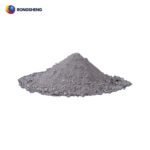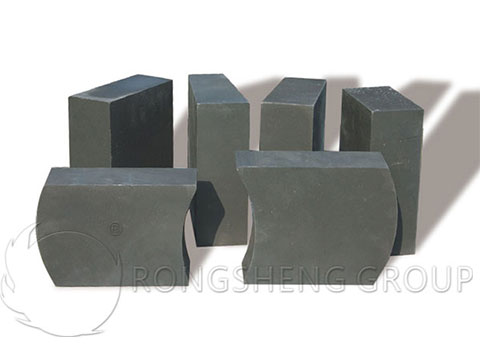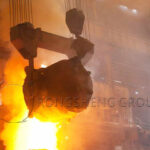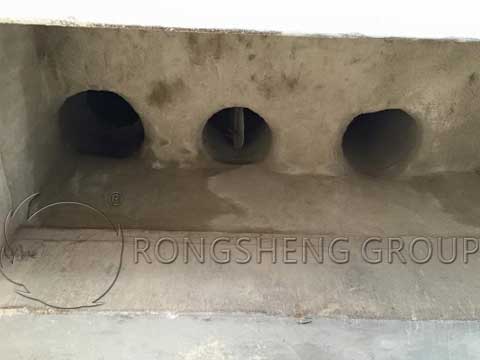Refractory Materials for Tundish Lining
Rongsheng Refractory Factory is a manufacturer of refractory materials for tundish. The tundish is an important equipment in the metallurgical continuous casting process, mainly used to receive molten steel from the ladle and inject it into the crystallizer. In the continuous casting process, the tundish plays the role of buffering, stabilizing and separating the molten steel, which is of great significance to improving the quality of the continuous casting billet. Therefore, the performance of the tundish has a direct impact on the stability of the entire continuous casting process and the quality of the billet. The refractory materials for the tundish are an important part of the lining of the tundish, and their performance and service life directly affect the working effect and production cost of the tundish.

Performance Requirements for Refractory Materials for Tundish
- Good high temperature resistance: The temperature of molten steel in the tundish is usually above 1500℃, even up to 1600℃. Therefore, refractory materials for tundish should have good high temperature resistance to ensure stability and service life under high temperature conditions.
- Good erosion resistance: Molten steel contains a large amount of impurities such as iron oxide and calcium oxide, which will have a strong erosion effect on refractory materials. Therefore, refractory materials for tundish should have good erosion resistance to ensure its service life.
- Good thermal shock resistance: During the continuous casting process, the temperature of molten steel in the tundish fluctuates greatly, which can easily cause cracks or even ruptures in the refractory materials. Therefore, refractory materials for tundish should have good thermal shock resistance to ensure its stability under temperature fluctuation conditions.
- Good air permeability: Refractory materials for tundish should have good air permeability to ensure the smooth discharge of molten steel and the smooth escape of gas, thereby ensuring the stability of the continuous casting process.
- Easy to construct and maintain: The refractory material for the tundish should be easy to construct and maintain to reduce production costs and improve production efficiency.
Selection Principles of Refractory Materials for Tundish
- Select appropriate refractory materials according to the working environment and use conditions of the tundish.
- Select appropriate refractory materials according to the composition and temperature of the molten steel.
- Select appropriate refractory materials according to the tundish design and use requirements.
- Select appropriate refractory materials according to production costs and economic benefits.
Selection of Tundish Structure and Lining Materials
According to the conditions such as the smelting method of the cast steel type and whether baking is required, the tundish can be roughly divided into the following types.
- (1) High-temperature tundish, which is set up for a specific metallurgical process and uses magnesium brick lining and top heating to about 1500℃.
- (2) Hot tundish, which is a common tundish, uses fired bricks or unfired bricks or castables as lining, and is preheated to 800~1100℃ before pouring.
- (3) Cold tundish, which uses insulation board as lining and can be used without preheating before pouring.

The refractory materials used in the tundish generally include the following parts:
(1) Insulation layer (10-30mm), which is adjacent to the steel shell of the tundish and is usually made of asbestos board, insulation bricks or lightweight castables. The best effect is the insulation fiberboard, which is about 12mm thick, has low thermal conductivity and is easy to lay.
(2) Permanent Layer(100-200mm), which is in contact with the insulation layer. Its material is generally clay bricks, and the overall lining is common. The castable is generally high-aluminum.
(3) Working layer (20-50mm), which is in contact with the molten steel and is a key part. The lining materials include semi-silica, wax stone, clay bricks, high-alumina bricks, alkaline bricks (such as magnesia bricks and zircon bricks. Or use insulation board: siliceous insulation board, magnesia insulation board, forsterite insulation board. Or use coating: magnesia, magnesia-chrome and magnesia-calcium coating, etc. At present, castables are also used as lining of the tundish.
(4) Seat bricks, embedded in the bottom of the tundish, used to install the tundish water nozzle, and its material is usually high-alumina.
(5) The bottom of the tundish, its material is basically the same as the working layer, and the working layer of the bottom of the tundish is easily damaged by the impact of molten steel. It requires corrosion resistance and wear resistance. Generally, high-alumina bricks or dense high-alumina bricks and aluminum-chrome bricks are used, and special large blocks of high-strength tar magnesia bricks are also used. Zircon bricks are also used to strengthen the impact area of molten steel.
(6) The cover is placed on the tundish to keep the heat and prevent the molten steel from splashing out. The cover is usually made of clay or high-alumina refractory castables.
(7) Slag retaining wall (weir), which is built inside the tundish and can be a single wall or a double wall. The slag retaining wall (weir) is usually made of high-alumina bricks or prefabricated blocks. It is used to retain slag. To improve the cleanliness of the molten steel, a molten steel filter can also be installed on the slag retaining wall.
The prefabricated refractory materials for the bottom of the tundish are sizing nozzle bricks, upper nozzle bricks and nozzle seat bricks.
Silica dry ramming material is used for the working layer of the tundish. The service life can reach about 30 hours after integral pouring, which is generally suitable for small and medium-sized tundishes.
The three major parts of the continuous casting tundish are the long nozzle, the integral stopper rod and the immersed nozzle. These three can control the flow of molten steel, dredge the molten steel, prevent the secondary oxidation of molten steel, and make the molten steel enter the crystallizer at a uniform speed during the use of the tundish, so as to realize the casting process.
In short, the performance and service life of the refractory materials for the tundish have a direct impact on the stability of the entire continuous casting process and the quality of the ingot. Therefore, the appropriate refractory materials should be selected according to the working environment of the tundish, the composition and temperature of the molten steel, the design requirements and the use requirements to ensure the stability of the continuous casting process and the quality of the ingot. At the same time, attention should also be paid to the research and development and application of new refractory materials to meet the ever-evolving industrial needs.





